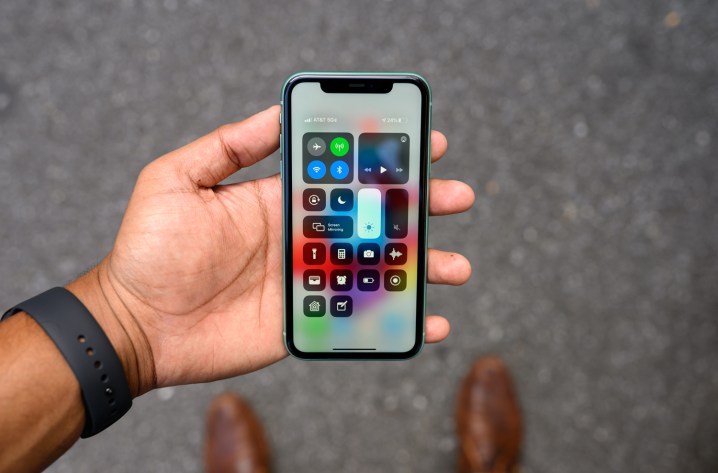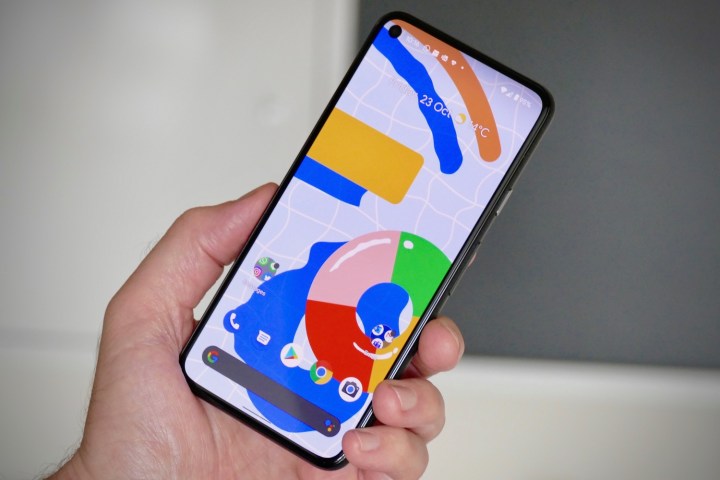The Google Pixel 5 is very much a Google flagship smartphone. Lacking some of the bells and whistles of more expensive phones by Samsung or Apple, it nonetheless gets the fundamentals spot-on. Its camera is unsurprisingly excellent, and it comes with very slick software, a sharp touchscreen, 5G support, and also a much bigger battery (compared to the Pixel 4). It’s also priced at a reasonable $700, making it a direct competitor to last year’s iPhone 11, which also begins at $699.
However, which phone is better: The Pixel 5 or iPhone 11? We pit the two devices against each other in a head-to-head, looking at how they compare in a number of categories. This should tell you all you need to know about the two smartphones.
Specs
| Google Pixel 5 | Apple iPhone 11 | |
| Size | 144.7 x 70.4 x 8 mm (5.70 x 2.77 x 0.31 inches) | 150.9 x 75.7 x 8.3 mm (5.94 x 2.98 x 0.33 inches) |
| Weight | 151 grams (5.33 ounces) | 194 grams (6.84 ounces) |
| Screen size | 6.0-inch OLED capacitive touchscreen | 6.1-inch Liquid Retina LCD |
| Screen resolution | 2340 x 1080 pixels (432 pixels per inch) | 1792 x 828 pixels (326 pixels per inch) |
| Operating system | Android 11 | iOS 14 |
| Storage | 128GB | 64GB, 128GB, 256GB |
| MicroSD card slot | Yes | No |
| Tap-to-pay services | Google Pay | Apple Pay |
| Processor | Qualcomm Snapdragon 765 | Apple A13 Bionic |
| RAM | 8GB | 4GB |
| Camera | Dual lens 12-megapixel wide, 16MP ultrawide rear, 8MP front | Dual lens 12MP and 12MP wide-angle rear, 12MP TrueDepth front |
| Video | 4k at 60 fps, 1080p at 30fps | 4K at 60 fps, 1080p at 240 fps |
| Bluetooth version | Bluetooth 5.0 | Bluetooth 5.0 |
| Ports | USB-C, 3.1 | Lightning connector |
| Fingerprint sensor | Yes, rear-mounted | No, FaceID instead |
| Water resistance | IP68 | IP68 |
| Battery | 4,080mAh
Fast charging (18W) Wireless charging Reverse wireless charging |
3,100mAh
Fast charging (18W charger sold separately) Qi wireless charging |
| App marketplace | Google Play Store | Apple App Store |
| Network Support | Verizon, Google Fi | T-Mobile, AT&T, Verizon, Sprint |
| Colors | Just Black, Sorta Sage | Purple, white, yellow, green, black, red |
| Prices | $699+ | $699+ |
| Review score | 4 out of 5 stars | 4 out of 5 stars |
Design, display, and durability

You might expect the latest Pixel to look like last year’s Pixel 4, but the Pixel 5 actually looks more like the midrange Google Pixel 4a. Gone are the unsightly forehead and chin bezels, and in their place is a tidy edge-to-edge display featuring a punch-hole selfie camera in the top-left corner. It also replaces the Pixel 4a’s underwhelming plastic body with aluminum, giving it a more solid build as well as a sleeker appearance. It may not be especially exciting compared to certain other flagships released this year, but it’s comfortable to hold and commendably light.
As for the iPhone 11, it’s good looking, but comes with no surprises whatsoever if you’ve held an iPhone X or anything later. It sports the signature notch at the top of its screen, while the rest of the display is edge-to-edge, albeit with slightly thicker bezels than the Pixel 5. Its frame is also made of aluminum.
The iPhone 11 is also somewhat disappointing when it comes to the quality of its 6.1-inch display. It offers a relatively low count of 1792 x 828 pixels. By comparison, the Pixel 5 packs 2340 x 1080 pixels, and with a slightly smaller 6-inch display. This makes its screen noticeably more vivid and detailed than the iPhone’s, an effect which is heightened further by the fact that its screen is OLED, while Apple uses an LCD panel. Additionally, the Pixel’s display is improved further by its 90Hz refresh rate.
Both smartphones have the same IP68 rating, indicating an ability to cope with immersion in as much as 1.5 meters of water for up to 30 minutes. Nonetheless, with a more vibrant screen and a slightly more appealing appearance, the Pixel 5 takes this opening round.
Winner: Pixel 5
Performance, battery life, and charging

The iPhone 11 and Pixel 5 are pretty evenly matched in price, but not in terms of performance. The iPhone 11 houses the same powerful A13 Bionic processor as the 11 Pro, and though it comes with only 4GB of RAM, this is more than enough to get the best out of the A13. Even if the phone is now one year old, it’ll still handle anything you can throw at it.
The Pixel 5 comes with twice the amount of RAM as the iPhone 11. But because iOS and Android smartphones use RAM differently, don’t put too much weight on that. The Pixel 5 also uses the midrange Qualcomm Snapdragon 765 chip, but it will lag behind the iPhone in pure power. That’s not to say it’s a slouch, but a newer, flagship-level processing chip could have offered more. On the other hand, the Pixel 5 comes with 128GB of internal storage as standard, while the iPhone 11 comes with only 64GB. You’ll have to pay $50 more for the 128GB version, making it more expensive than Google’s phone.
Longevity is something that tripped up the Pixel 4, yet the Pixel 5 comes with a very generous 4,080mAh battery. This makes it more capable than the iPhone 11’s 3,100mAh cell, with our review finding that it easily lasts a full day under heavy use, as well as two days under lighter use. Our review found that the iPhone 11 ends a day of heavy usage with around 15% of capacity left, so even with a smaller battery, it’s still pretty reliable.
With a lead in performance and a capable full-day battery, we’re giving this to the iPhone. The Pixel 5 offers more internal memory, and while it has a very strong battery, the iPhone’s stronger specs allow it to pull ahead here.
Winner: iPhone 11
Cameras

Both phones opt for dual-lens rear cameras. The iPhone 11 packs dual 12-megapixel ultrawide and wide-angle camera lenses, while the Pixel 5 has a 12MP wide lens and a 16MP ultrawide lens. These are both fairly modest specs-wise, at least compared to more premium smartphones. However, Google and Apple are the best two phone manufacturers for camera software, so you end up with two excellent cameras.
Compared to previous models, the iPhone 11’s camera has been improved by such features as Smart HDR and faster autofocus. It also benefits from semantic rendering, which uses artificial intelligence (A.I.) to make sense of each picture and enhance the overall dynamics. This makes it much easier to simply point the phone at things and take pictures, leaving you with great photos in most situations.
Given the pedigree of the Pixel 4 and Pixel 4a, the Pixel 5 had a lot to live up to, but it certainly doesn’t disappoint. It harnesses Google’s A.I. and machine-learning prowess to take beautiful shots whatever the condition, while the addition of a 16MP ultrawide lens gives it extra versatility. Google has also added a few new features, such as Cinematic Video and the ability to use Night Sight while in Portrait Mode. This all adds up to the Pixel 5 being one of the best camera phones around, even if it doesn’t offer a massive generational leap compared to the Pixel 4.
Both the iPhone 11 and Pixel 5 can capture 4K video at 60 fps, although the iPhone 11 can shoot 1080p footage at a higher 240 fps frame rate. This is only a minor advantage, so because the Pixel 5 offers a better all-round camera, we’re giving it a narrow win in this round.
Winner: Google Pixel 5
Software and updates

The iPhone 11 uses iOS 14, while Pixel 5 runs on Android 11. Choosing which of these operating systems is better is like choosing between chocolate and cheese: each one has their own pros and cons, making them hard to compare directly. Still, iOS 14 is very user-friendly and secure, while it arguably has an iconic design. Android 11 is much more customizable, offers a wider selection of apps, and provides a handy always-on display.
Compared to other Android smartphones, the Pixel 5 is one device that will provide you with regular updates and a decent lifetime of support. Taking this together with the different operating systems, we have to declare another tie.
Winner: Tie
Special features

While the two phones have been pretty evenly matched up until now, the Pixel 5 does boast one thing the iPhone 11 doesn’t: Support for 5G. It’s compatible with sub-6Hz and the faster mmWave 5G bands, so Google’s phone will provide the fastest possible download speeds in areas with a 5G signal.
This puts the iPhone 11 at something of a disadvantage, but Apple’s phone does have a few more modest special features. Its TrueDepth camera supports Face ID, which can be used for unlocking the phone, for payment or ID, and Apple’s fun Animoji. It’s worth noting that the Pixel 4 came with a face-unlock system, but that the Pixel 5 ditches this and returns to a rear-mounted fingerprint sensor.
Face ID also lets you use Animoji and Memoji, which are lighthearted avatars you can create in order to use during FaceTime calls (and in messages). The iPhone 11’s night-mode camera feature is also one of the best on the market, while its dual speakers enable pretty decent surround sound.
Lastly, the Pixel 5’s display enables a 90Hz refresh rate, while the iPhone 11 can muster only 60Hz. This doesn’t make a massive difference, but it is noticeable, particularly when combined with a higher resolution. When this is taken into account along with the 5G support, this round ends up being a slim victory to Google’s phone.
Winner: Google Pixel 5
Price and availability
The iPhone 11 is available unlocked directly from Apple, and it’s also widely available from every major carrier. It starts at $699. The 128GB version will set you back $749, while the 256GB version pushes the price tag up to $849.
The Pixel 5 is available from Google for $699 and will ship in the U.S. from October 29. It will be supported by Verizon, Google Fi, and AT&T, and you’ll also be able to buy it from Amazon.
Take a look at some of the best Google Pixel deals and iPhone deals we’ve found ahead of Cyber Monday.
Overall winner: Google Pixel 5

The iPhone 11 may not be too far behind, but the Pixel 5 is the better smartphone overall. It features a slightly more modern design, its display is distinctly crisper and clearer, it offers double the storage as standard, and it also supports 5G. That’s not to say that the iPhone 11 isn’t worth a look. Its performance and battery life at least matches Google’s phone, while if you prefer iOS to Android, it’s obviously the way to go.
Nonetheless, the Pixel 5 is the winner here. It continues Google’s evolving tradition of delivering a streamlined, hard-to-beat core smartphone experience, with its camera remaining one of the best in the business. It’s undoubtedly one of the best Android phones in the business.



